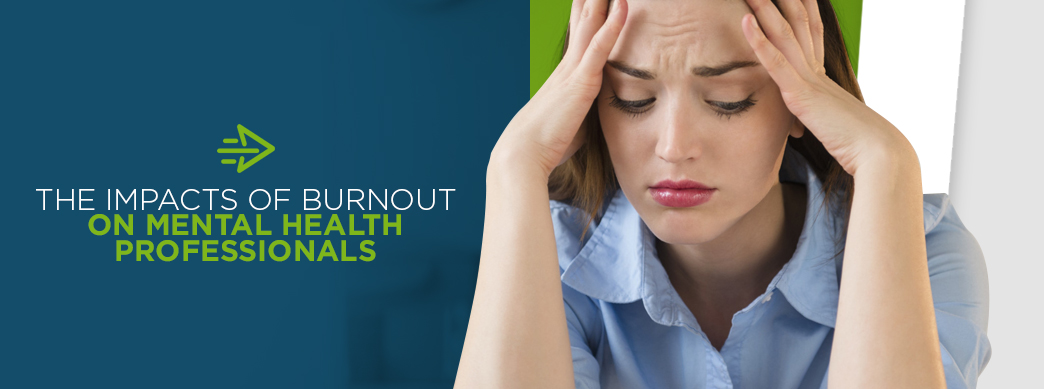How to Prevent Burnout as a Healthcare Professional
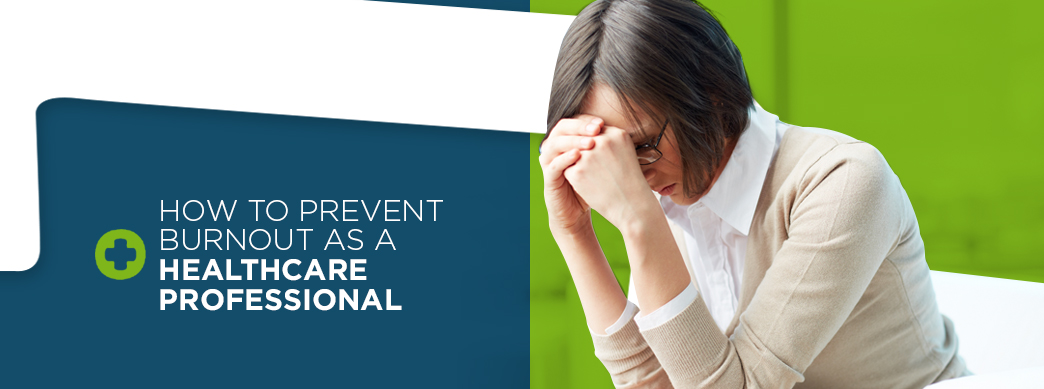
The healthcare industry is a field that is both challenging and gratifying for its professionals. Facing life-or-death issues day in and day out can take a toll on even the most competent people. Adding in long hours and demanding workloads, the emotional drain from working in healthcare can be challenging to cope with. Patients trust behavioral healthcare clinicians with heavy secrets and shocking stories daily. Burnout is highly prevalent in this field, and recognizing it can help prevent it from decreasing the quality of patient care.
Table of Contents
- What is Burnout?
- Signs of Burnout in the Healthcare Industry
- The Impacts of Burnout on Mental Health Professionals
- How to Prevent Burnout in Your Practice
What Is Burnout?
Anyone who has worked in behavioral healthcare has likely seen at least one professional experiencing burnout. There are multiple ways to define burnout, although researchers use the Maslach Burnout Inventory most often. This definition takes a three-pronged approach to explain burnout.
- Emotional exhaustion: When a professional is experiencing this facet of burnout, they tend to feel depleted. They may also feel like they are overextending their abilities and feel general fatigue as a result.
- Depersonalization: This facet is also called cynicism. A professional will develop negative or contemptuous attitudes toward their patients and work.
- Reduced personal accomplishment: Professionals experiencing burnout begin to feel like they are not making a difference in their role, thus leading to a negative feedback loop which reduces job performance.
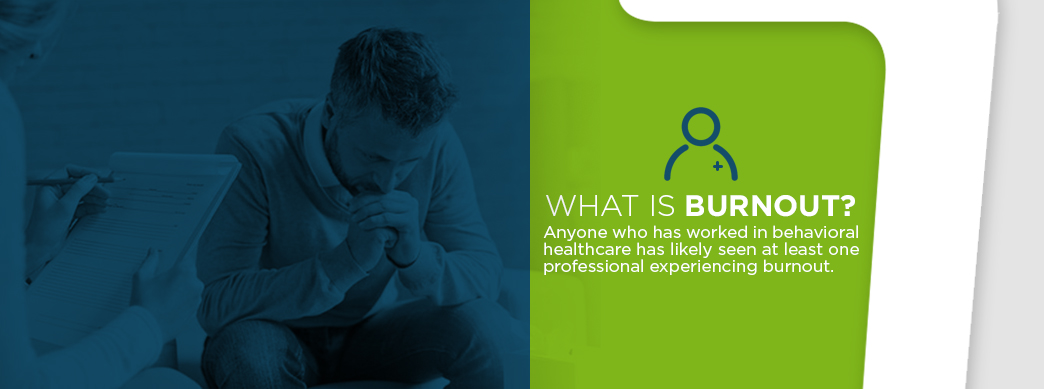
Those working in behavioral health have some of the highest levels of general dissatisfaction and burnout among all healthcare services. Because recruiting and training staff in mental health services is so expensive, allowing exhaustion to grow unchecked ends up being economically wasteful, in addition to lowering the quality of care. Recognizing burnout and taking steps to help prevent it is crucial in maintaining a healthy environment for both patients and staff.
Upcoming Webinar
Understanding Vicarious Trauma, Compassion Fatigue, and Burnout
Tuesday, December 12th 2023, 1:00 PM EST
Are you a dedicated mental health clinician looking to enhance your self-care, better serve your clients, and cultivate mindful attention to your needs? Join us for a transformative webinar led by Bea Sanders, LCSW, a passionate licensed clinical social worker from Northwest Arkansas.
Webinar Highlights:
- Exploring Emotional Toll
- Differentiating Challenges
- Prevalence and Impact
- Effective Strategies
- Free Resource Guide
This webinar is free of charge and promises to be a game-changer for your professional and personal growth. Secure your spot today by registering now.
Signs of Burnout in the Healthcare Industry
The symptoms of burnout strongly resemble those of general stress and anxiety. Telling when stress isn't a temporary situation can be difficult, and requires some shrewd observation. Look out for the following signs when trying to identify healthcare burnout.
- Chronic fatigue: Healthcare professionals are a tired bunch due to the nature of the job. When hours stack up and demanding patients cause trouble, it's hard not to feel tired. But chronic fatigue that lasts days or weeks without letting up is both a predictor and symptom of burnout.
- Forgetfulness: As a strong sign of emotional exhaustion, inattention is a problematic aspect of burnout. When professionals become disengaged, they tend to forget simple things that used to be a matter of routine. Forgetfulness is one of the more dangerous signs of burnout.
- Pessimism: When a staff member is experiencing burnout, they often feel like the world is against them. When someone goes from seeing the glass as half-full to seeing it as half-empty, they may be experiencing the depersonalization element of burnout.
- Isolation: It's essential to set boundaries in such an emotionally charged field, but it can be a sign of burnout when a professional begins to withdraw from their normal level of social engagement. They may stop their usual small talk, avoid the break room or otherwise show their loss of interest in being a part of the team.
- Irritability: Behavioral health professionals have ample reason to be cranky now and then, but pervasive irritability is a classic burnout symptom that can drag down team morale.
- Poor performance: Professionals experiencing burnout don't do their jobs as well as they previously did. The stress and anxiety they feel are distracting and keep them from performing at their best.
Overall, a behavioral health professional with burnout demonstrates through their attitudes and actions that they don't want to be at work. When all the symptoms of burnout combine, they result in things like:
- Missing or being late to appointments
- Feeling more judgmental or bitter toward clients
- Giving up on advanced training
- Daydreaming at work
- Feeling unable to disengage from work while at home
When you spot one or more of these symptoms in a co-worker or yourself, it may be tempting to brush them off as the results of temporary stress. It's crucial to take a good look at burnout symptoms and evaluate them in terms of time. If symptoms last more than a week without letting up, burnout is likely to be the culprit, and you must address it to avoid continuing decline in your organization's quality of care.
It's harder to quantify the effects of burnout on mental health professionals than it is for physicians. However, looking at the effects of exhaustion on doctors gives us a solid idea of how strongly burnout can alter outcomes for any healthcare professional. One recent body of research investigated the results of 47 studies on burnout, with a total of more than 42,000 doctors involved.
The meta-analysis made it abundantly clear patients suffer when healthcare professionals burn out. The study considers three specific criteria.
- Patient safety incidents: Adverse events such as errors in diagnosis compromise patients' safety and comfort.
- Professionalism: Low professionalism includes a lack of empathy and weak communication with all one's patients.
- Patient satisfaction: Patients reported their data on satisfaction with their physician via surveys.
Some of the most influential pieces of evidence include the fact that physician burnout doubled:
- The chance of being involved in a patient safety incident
- The chances of physicians displaying low professionalism
- The odds of low patient satisfaction
Interestingly, the study also found that the earlier burnout occurs, the more it affects professionalism. The researchers wrote: "The... association of burnout with low professionalism was significantly larger across studies based on residents and early-career physicians, compared with studies based on middle-and late-career physicians."
In other words, burnout has a more significant effect on professionals at the beginning of their careers. This time is when they are developing the professional values they will carry with them through the rest of their working lives, and early burnout has the worst effects on professionalism.
The study also found that depersonalization was the most influential risk factor in multiple areas. For instance, depersonalization increased the risk of low professionalism threefold, and more than quadrupled the risk of low patient satisfaction.
For behavioral health professionals, the risks of burnout cover many areas. The research available is limited, but one review compiles the evidence and makes a compelling case for focusing on the prevention of burnout. These are some of the impacts the study brings to light.
1. Diminished Mental Health
Burnout results in substantially diminished mental health. It has linked with increases in issues including depression, anxiety, impaired memory, insomnia and the consumption of alcohol. According to the results of a standardized clinical interview, employees experiencing mild burnout were more than three times more likely to have major depression. The worse burnout is, the more likely it is to result in depression. Those experiencing severe burnout were an astonishing 15 times more likely to suffer from major depressive disorder.
2. A decline in Physical Health
Burnout has physical manifestations, too, including neck and back pain, as well as more severe symptoms. High levels of burnout, especially the aspects of depersonalization and emotional exhaustion, have linked to increased reports of flu-like symptoms and gastroenteritis. This example is one of many to demonstrate how mental and physical health interact, a concept that informs holistic practices which may help alleviate or prevent burnout.
3. Reduced Organizational Performance
Burnout doesn't just affect the person suffering from it. Employees with burnout often show display less commitment to their organization, spread negative attitudes and have higher rates of absenteeism. Turnover is one of the most difficult organizational hurdles to clear when dealing with burnout.
One of the studies determined burnout was a major predictor of future sick leave — even when researchers controlled for previous absences, occupation, gender and age.
How to Prevent Burnout in Your Practice
To keep burnout from sabotaging your employees' happiness and productivity, proactivity is the best approach to take. There is no single one-size-fits-all solution to preventing burnout, but the following six strategies can help safeguard healthcare professionals mental health.
1. Improve Workflow Design
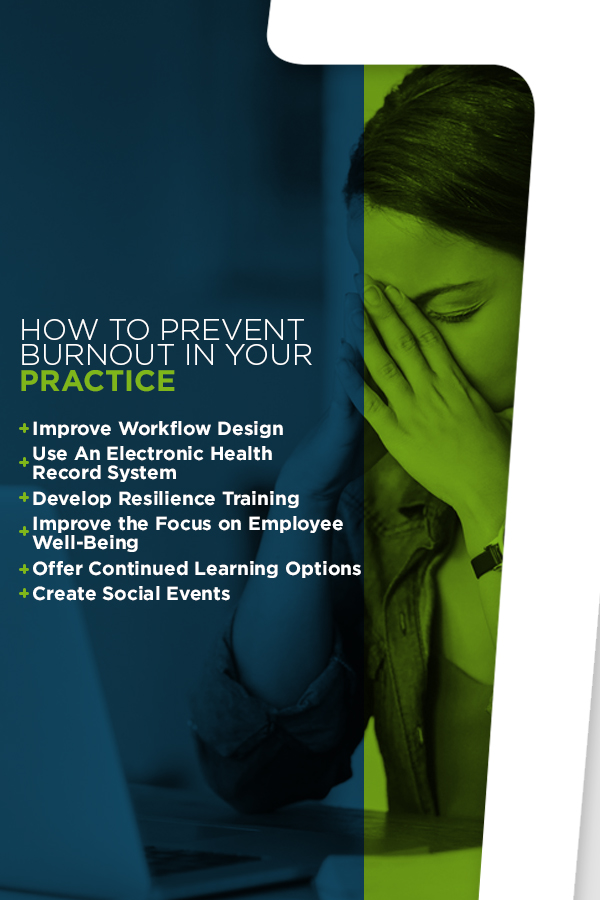
Often, burnout can be the result of having too much to do without enough time in which to do it. If you're a psychiatrist, you don't want to spend your time pulling charts or performing other similar clerical tasks. One way to prevent burnout is to redesign the workflow at your practice to allow professionals to do the work no one else can do. For instance, a psychiatrist treating someone with improving depression might opt to delegate that case to a psychiatric nurse practitioner who can continue to prescribe the patient's medication.
Figuring out how to adapt workflow so everyone is making the best use of their time requires complex thought, especially when the organization in question has many employees. However, the work you put into a redesign will pay off in the long run as each employee can focus more on the core duties of their job.
2. Use An Electronic Health Record System
An electronic health records (EHR) system goes a long way in reducing the incidence of burnout for mental healthcare professionals. Using the wrong EHR can contribute to stress for clinicians, so it's important to choose one like ICANotes, which is specially designed for behavioral health professionals.
EHRs can remove the stress and time drain associated with creating documentation the traditional way, and often can help with administrative tasks like scheduling and sending out appointment reminders. Some EHR systems feature patient portals that make for easy communications safeguarded by HIPAA protections. An EHR helps clinicians use their time efficiently and for the most impact, thereby reducing the emotional exhaustion that drives burnout.
3. Develop Resilience Training
Resilience refers to an individual's ability to handle stress and recover quickly from the effects of adversity. The ability to bounce back can make the difference between burnout and a temporary bout of stress or anxiety. Offering resilience training to employees increases their emotional and cognitive strength so they are better able to adapt to the continually evolving, high-stress environment of behavioral healthcare.
4. Improve the Focus on Employee Well-Being
Many employees dealing with burnout feel their organization doesn't value their well-being. This belief is dangerous because it can fuel the negative feelings associated with burnout, leading to noticeable reductions in performance. It also lessens the likelihood of the employee seeking appropriate counseling, due to fear of potential rejection or reprisal.
Behavioral health professionals should feel secure knowing that management cares about them, and one way to do that is to highlight burnout from the get-go. Giving employees access to the Maslach Burnout Inventory (MBI): Human Services Survey for Medical Personnel empowers them to monitor their mental health for signs of burnout before it becomes a significant issue.
5. Offer Continued Learning Options
Burnout can sometimes be caused by feelings of stagnation in one's job. If professionals aren't learning something new or receiving training on how to improve in their careers, it's easy to start feeling discouraged and give in to burnout. When employees feel more in control and more confident in their careers, they ascribe more significant meaning to the tasks they perform every day. This perspective helps prevent depersonalization, the most dangerous aspect of burnout from a patient point of view.
6. Create Social Events
It's not realistic to expect everyone in your practice to be best friends, and it wouldn't necessarily be healthy even if they were. However, a little social interaction can help build a team mentality that makes it harder for burnout to take root. Social connection is a strong predictor of reduced stress and happiness, which in turn helps prevent burnout. Social connection also leads to employees who are more engaged in their work, which translates to improved patient satisfaction and reduction of burnout-related turnover.
You don't need to set up office-wide ski trips or island retreats. Something as simple as a potluck or small office birthday party is often enough to boost social connection among staff members.
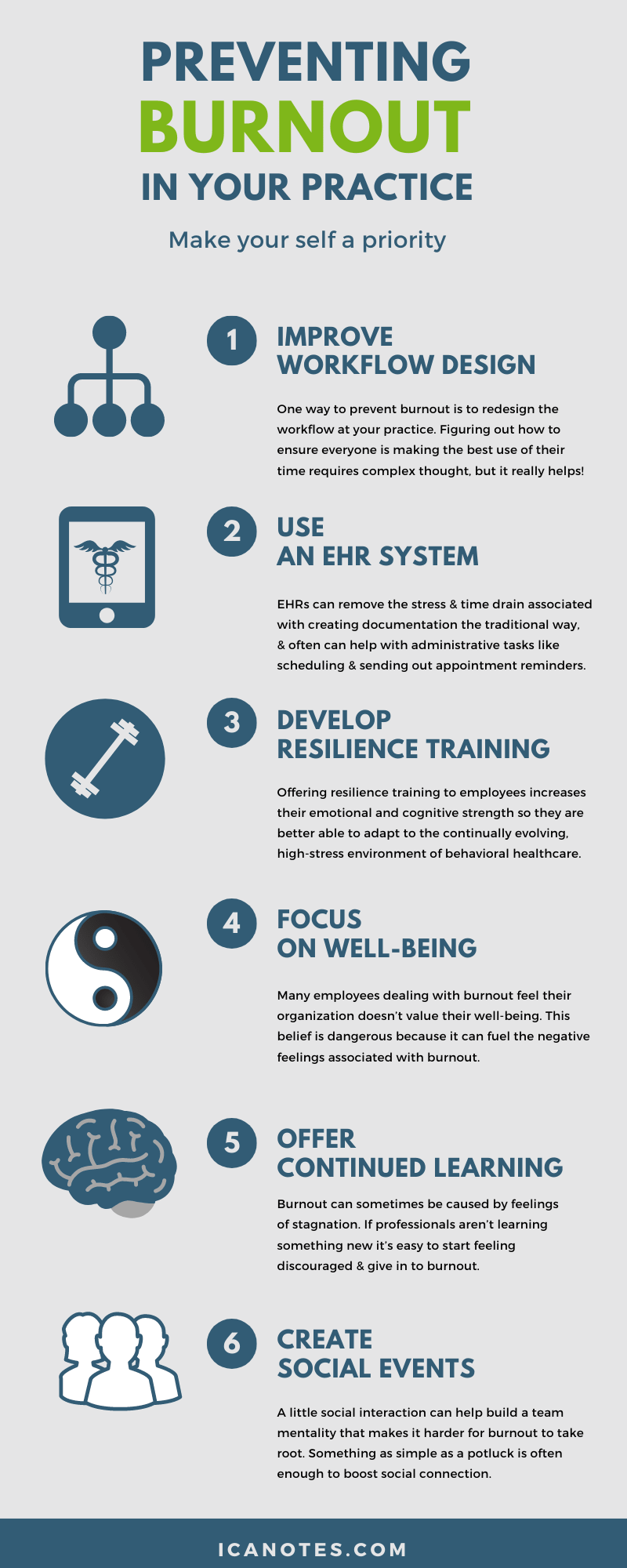
Beat Burnout With ICANotes
In healthcare, burnout has serious consequences. If it goes unchecked, patients will suffer from a dip in their quality of care, and it's usually easy to see when a clinician has become disengaged from the appointment. Taking steps to reduce the strain on practitioners and support staff is crucial in maintaining the highest standards as well as providing the best working environment for employees.
The simplest and most cost-effective place to start is by choosing an EHR that suits the needs of your practice. ICANotes was explicitly built for clinicians, to eliminate all the hassle and headache of creating documentation. Instead of spending time writing and sifting through notes, you can use our intuitive point-and-click interface to generate documentation more swiftly and accurately than ever before.
Practice management capabilities handle scheduling, appointment reminders and messaging to free up administrative staff for other tasks. And the whole system is HIPAA-compliant, so you can get peace of mind knowing you have found a safe, secure storage solution for your patients' data.
ICANotes can enhance your practice's quality of care in a variety of ways, and seeing it in action is the best way to find out how our EHR can benefit you. Schedule a live demo to see just how ICANotes can lead you to a better practice and less healthcare burnout.
Related Posts
Strategies for Reducing Stress, Anxiety and Burnout in the Workplace
Most Common Industries Affected by Mental and Behavioral Health Issues
What Are the Most Common Mental Health Disorders in the United States?
The Trend Toward Integrated Healthcare: Mental and Physical Health
Sources
- https://www.wilmarschaufeli.nl/publications/Schaufeli/311.pdf
- https://www.tandfonline.com/doi/abs/10.1080/09638230500512482
- https://jamanetwork.com/journals/jamainternalmedicine/article-abstract/2698144?widget=personalizedcontent&previousarticle=2701633
- https://www.ncbi.nlm.nih.gov/pmc/articles/PMC3156844/
- https://www.ncbi.nlm.nih.gov/pubmed/16078523/
- https://www.mindgarden.com/315-mbi-human-services-survey-medical-personnel
- https://www.forbes.com/sites/alankohll/2018/01/31/5-ways-social-connections-can-enhance-your-employee-wellness-program/#3459455e527c

